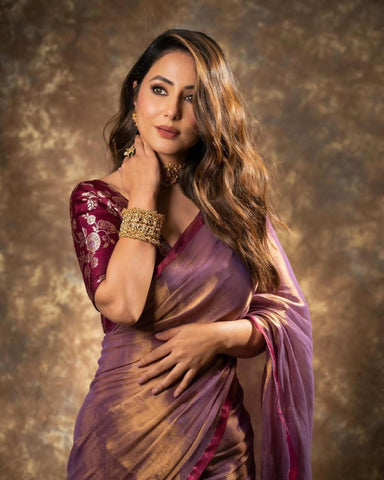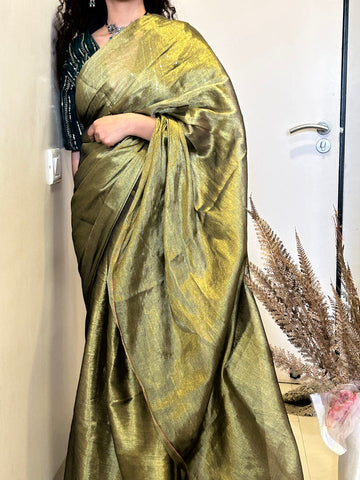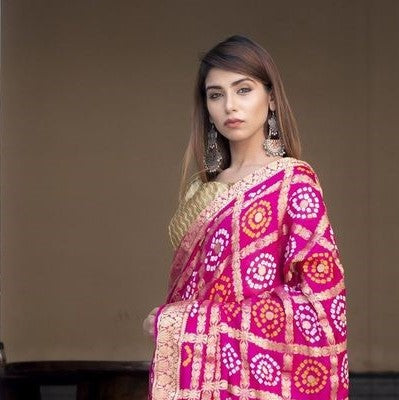
The History of Banarasi Tissue Silk Sarees: Carrying Legacy and Heritage Forward
The origin of Indian textiles can be traced back to the Indus Valley Civilization. Yet only a few fabrics carry the same level of prestige and tradition as Banarasi silk. Among the many variations of this luxurious textile, the Banarasi tissue silk sarees are a beautiful and intricate form of traditional authentic Indian clothing that has stood the test of time.

Known for their lightweight fabric, the finely woven zari threads give them the most elegant shimmer. These sarees not only showcase the skill and craftsmanship of Banarasi weavers but also carry with them a rich history and cultural significance that has been passed down through generations. In this blog, we will delve into the fascinating history of Banarasi tissue silk sarees, exploring their origins, production process, and enduring legacy.
Going back in time to the first page: The history-
The history of Banarasi silk dates back to ancient times, with references to silk weaving found in Hindu scriptures and historical texts. Varanasi, or Banaras as it is now commonly known, emerged as a center of silk production and trade, attracting skilled artisans from across the Indian subcontinent.
But it is in the Mughal Period that this fabric truly flourished and developed into what it's known for today!
It is believed that the art of silk weaving was brought to the city of Banaras (now Varanasi) by Persian artisans during the reign of Mughal Emperor Akbar.
The love of luxury and fine textiles inspired the then royalty to introduce new styles and techniques to weaving and overall the textile industry.
The introduction of the Zari brocade is what sets them apart though. Very highly-priced for this specific reason, metallic threads, typically gold or silver, are woven directly into the fabric. And over time the zari brocade was infused with the tissue silk saree, to give us this finished product which is now a legacy in itself.
Did you know~ that Banarasi Silk Sarees take around 15 to 45 days to complete, as they are handwoven by karigars
Worn by brides on their wedding day and adorned by women during festive celebrations and religious ceremonies, these sarees embody the timeless elegance of Indian attire.
Banarasi tissue silk sarees, in particular, are renowned for their lightweight and translucent quality, making them ideal for draping elegantly. The word "tissue" refers to the delicate and sheer nature of the fabric, which is achieved through a meticulous weaving process involving fine silk threads. These sarees are characterized by their subtle sheen and intricate designs, often featuring motifs inspired by nature, mythology, and Mughal architecture.

From silk to saree: The process-
The production of Banarasi tissue silk sarees is a labor-intensive and time-consuming process that requires the expertise of skilled artisans. It begins with the sourcing of high-quality silk yarn, which is then dyed in vibrant hues using natural or synthetic dyes. The weaving process, carried out on traditional handlooms, requires careful attention to detail as the intricate designs and motifs are created which are the prime characteristic of Banarasi Silk Sarees.
One of the distinguishing features of Banarasi tissue silk sarees is their durability. Despite their lightweight and airy feel, these sari's are surprisingly strong and long-lasting. Since the silk used is of the highest quality and the weaving is done with utmost precision. This is what allows the saree to be passed through generations and ultimately become heirloom pieces daughters cherish.
The use of zari or metallic thread, adds a touch of opulence and grandeur to the fabric. The intricate zari work seen in Banarasi tissue silk sarees requires immense skill and precision, with artisans often spending hours meticulously crafting each design by hand.
Heritage piece acquired: Enduring Legacy-
Over the centuries, Banarasi tissue silk sarees have remained a symbol of luxury, elegance, and timeless beauty. Another very appealing feather in the hat- the saree's versatility is the chef's kiss.
Earlier only worn by royalty and aristocracy, these sarees have adorned the most prestigious occasions, from weddings and religious ceremonies to festive celebrations and cultural events. But today, they are highly coveted by women across India and around the world, cherished for their exquisite craftsmanship and heritage value. These Tissue Silk sarees are suitable for a wide range of occasions and come in a variety of colors and designs, making it easy to find a saree that suits your personal and preferred style and tastes.
While the traditional craftsmanship of Banarasi sarees remains unchanged, modern innovations and adaptations have infused new life into this ancient art form. Contemporary designers have been now experimenting with innovative techniques, colors, and patterns to create sarees that appeal to a younger generation of buyers. From lightweight and breezy sarees for summer weddings to embellished and ornate sarees for grand occasions, Banarasi tissue silk sarees continue to evolve to meet the demands of modern fashion.
Yet continue to hold cultural significance, serving as a link to India's rich textile heritage. They embody the traditions and craftsmanship of generations of weavers, whose skills have been passed down through centuries.
Acting as a bridge between traditional and modern India, these sarees remove the gaps between generations too.
By preserving and promoting the art of Banarasi silk weaving, we at Jhakhas honour the legacy of these artisans and ensure that their exquisite creations continue to be cherished for generations to come.

To sum it up: The Conclusion-
Wearing a Banarasi tissue silk saree is not just about making a fashion statement; it is a tribute to the rich legacy of Indian textiles and craftsmanship. From ancient times to the modern era, these sarees have remained a symbol of elegance, grace, and luxury. The weavers and artisans breathe life into each delicate thread, weaving together a legacy that has transcended time.
In a world where fast fashion dominates, Banarasi tissue silk sarees stand as a testament to the enduring beauty of traditional craftsmanship. These exquisite sarees carry with them a rich history and cultural significance that transcends time, making them much more than just pieces of fabric. As we continue to embrace the beauty of Banarasi tissue silk sarees, we carry forward a legacy of craftsmanship and heritage that will forever remain woven into the fabric of Indian culture.
There are a lot of Indian textiles that come from similar rich histories and slowly we’ll cover them all. Tell us which fabric or type of saree you want to hear about next. Meanwhile, keep an eye out on our website and Instagram page for updates on the latest trends and newest collections. Also, connect on Facebook and Pinterest for more aesthetic content.












Leave a comment
This site is protected by hCaptcha and the hCaptcha Privacy Policy and Terms of Service apply.